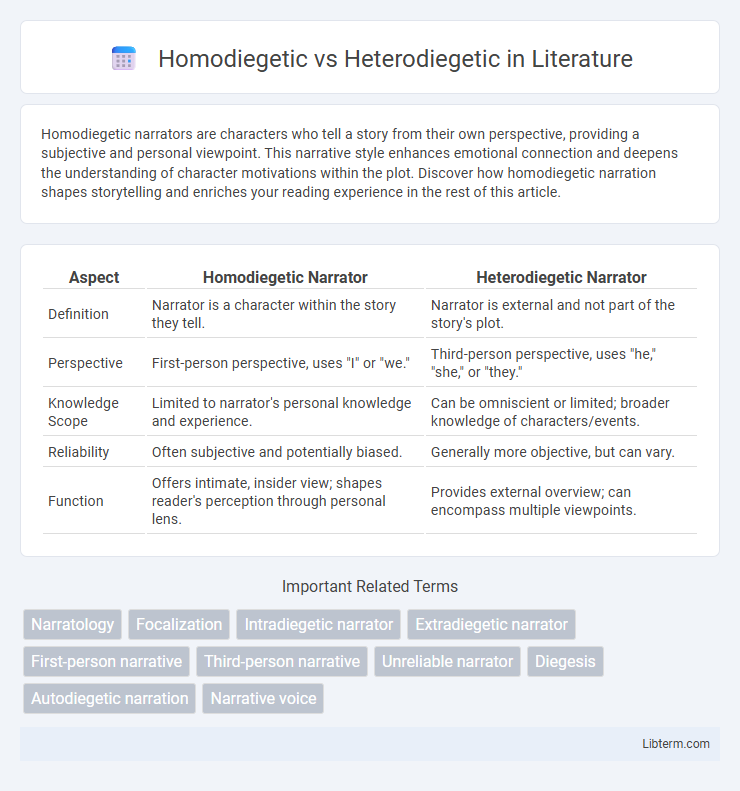Homodiegetic narrators are characters who tell a story from their own perspective, providing a subjective and personal viewpoint. This narrative style enhances emotional connection and deepens the understanding of character motivations within the plot. Discover how homodiegetic narration shapes storytelling and enriches your reading experience in the rest of this article.
Table of Comparison
| Aspect | Homodiegetic Narrator | Heterodiegetic Narrator |
|---|---|---|
| Definition | Narrator is a character within the story they tell. | Narrator is external and not part of the story's plot. |
| Perspective | First-person perspective, uses "I" or "we." | Third-person perspective, uses "he," "she," or "they." |
| Knowledge Scope | Limited to narrator's personal knowledge and experience. | Can be omniscient or limited; broader knowledge of characters/events. |
| Reliability | Often subjective and potentially biased. | Generally more objective, but can vary. |
| Function | Offers intimate, insider view; shapes reader's perception through personal lens. | Provides external overview; can encompass multiple viewpoints. |
Introduction to Narrative Perspectives
Homodiegetic and heterodiegetic narrators define the narrative perspective by their presence within the story world; homodiegetic narrators participate as characters, providing subjective insights and personal experiences. In contrast, heterodiegetic narrators exist outside the story, offering an external and often more objective viewpoint on events and characters. Understanding these narrative perspectives is essential for analyzing the level of reliability, focalization, and narrative bias in storytelling.
Defining Homodiegetic Narration
Homodiegetic narration refers to a storytelling perspective where the narrator is also a character within the story world, participating in the events and sharing personal experiences. This narrative mode allows for subjective insights and emotional depth as the narrator's thoughts and feelings are directly conveyed to the audience. Contrastingly, heterodiegetic narration involves a narrator who exists outside the story world, offering an external and often more objective viewpoint.
Understanding Heterodiegetic Narration
Heterodiegetic narration occurs when the narrator exists outside the story's world, providing an external perspective that often results in an omniscient or limited point of view. This narrative mode contrasts with homodiegetic narration, where the narrator is a character within the story, sharing personal experiences and subjective insights. Understanding heterodiegetic narration enhances analysis of narrative distance, reliability, and the scope of information delivered to the audience.
Key Differences Between Homodiegetic and Heterodiegetic
Homodiegetic narrators participate as characters within the story they narrate, offering a subjective, first-person perspective that deeply engages with the plot and other characters. Heterodiegetic narrators exist outside the story world, providing an external, often omniscient viewpoint that allows for a broader, more objective overview of events and characters. The key difference lies in the narrator's involvement: homodiegetic narrators are embedded in the narrative's reality, while heterodiegetic narrators remain detached observers.
Examples of Homodiegetic Narrators in Literature
Homodiegetic narrators appear as characters within the story they tell, providing a personal and subjective perspective, as seen in Holden Caulfield from J.D. Salinger's *The Catcher in the Rye* and Ishmael in Herman Melville's *Moby-Dick*. These narrators often use first-person pronouns, allowing readers direct access to their inner thoughts and emotions. The homodiegetic narrative technique enhances intimacy and reliability, which contrasts with heterodiegetic narrators who remain outside the story's world.
Notable Heterodiegetic Narrators in Classic Texts
Notable heterodiegetic narrators in classic literature include the omniscient voice of the narrator in Leo Tolstoy's "War and Peace," who possesses comprehensive knowledge beyond any character's perspective. Another prime example is the narrator in Jane Austen's "Pride and Prejudice," offering an external, third-person viewpoint that provides insight into multiple characters and social contexts. These narrators remain outside the story world (heterodiegetic), contrasting with homodiegetic narrators who participate within the narrative they recount.
Impact on Reader Engagement and Perception
Homodiegetic narrators, who participate in the story as characters, create a sense of intimacy and immediacy that often enhances reader engagement by offering a personal perspective. Heterodiegetic narrators, existing outside the story world, provide a broader, more objective viewpoint that can shape reader perception through comprehensive insight or omniscient knowledge. The choice between homodiegetic and heterodiegetic narration significantly influences how readers connect emotionally with the narrative and interpret character motives and events.
Narrative Reliability: Homodiegetic vs Heterodiegetic
Homodiegetic narrators, as characters within the story, often provide a subjective perspective shaped by personal biases and limited knowledge, affecting narrative reliability. In contrast, heterodiegetic narrators, positioned outside the story world, tend to offer a more detached and potentially omniscient viewpoint, enhancing reliability through broader insight. The distinction between these narrative modes is crucial for analyzing the trustworthiness of the narrated account and the degree of internal consistency within the narrative.
Choosing the Right Narrator for Your Story
Selecting the appropriate narrator--homodiegetic or heterodiegetic--significantly shapes narrative perspective and reader engagement. Homodiegetic narrators participate in the story, offering intimate insights and firsthand experiences, which enhances emotional connection and reliability. Heterodiegetic narrators exist outside the story world, providing a broader, more objective overview and enabling complex storytelling through omniscient or limited viewpoints.
Conclusion: Narrative Voice and Storytelling Success
Homodiegetic narrators, who participate in the story, create intimacy and subjective insight, enhancing emotional resonance and character depth. Heterodiegetic narrators, external to the story, offer comprehensive perspective and reliability, supporting complex plot development and thematic clarity. Choosing between homodiegetic and heterodiegetic narration critically shapes storytelling effectiveness by balancing immersion, credibility, and reader engagement.
Homodiegetic Infographic

 libterm.com
libterm.com